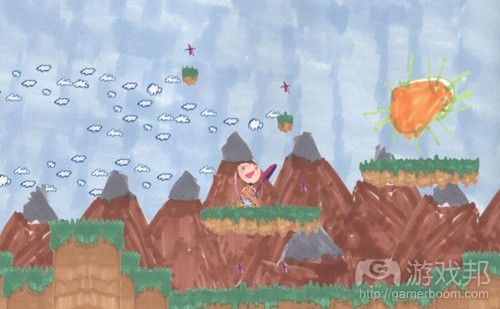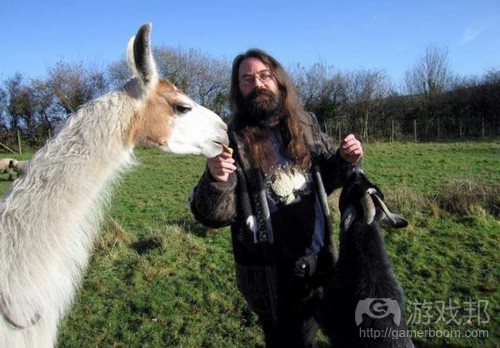关于独立游戏及其开发者的7个真实神话
作者:Chris Priestman
在我的上篇文章中,我揭露了7个虚假的独立游戏神话。我决定继续揭露这个领域的真相。独立游戏界有太多神话似的故事,但没有人能肯定哪些是传说,哪些是真相。这是一个值得探索的话题,且出于某些奇怪的原因,似乎还没有什么人深入研究过。
这一次,我们将看到的是真实的“神话”,尽管外界普遍不认为它们是真实的。我会让事实说话的。但愿你已经做好接受残酷真相的心理准备!
1、独立游戏开发者的形象跟他们的游戏一样
我要举的例子是Michael Brough。他做过不少漏洞百出的冒险游戏和希奇古怪的益智游戏。有些人说他的游戏丑陋,他们没有意识到的,他们的评价正是对Brough本人的胡须和着装风格的嘲弄和污蔑。你没见过这家伙光辉灿烂的时候吧?相信我;你最好不要以无礼的言论冒犯他,否则他可能会把你丢到窗外,然后用大锤让你粉身碎骨。去看看他的毕业项目吧。
你是不是认为Phil Fish戴土耳其毡帽(游戏邦注:土耳其毡帽的英文就是“fez”,而此人凭借游戏《Fez》摘得2012年游戏开发者大会颁发的最佳独立游戏大奖)是巧合?!独立开发者太专注于自己的游戏了,或多或少会把自己的形象放进游戏里。无论是形状、形式、阴影还是颜色,你都可以在独立游戏中找到创作者本人的影子。这是真的。
2、独立开发者过着野人般的生活
如上图所示,你可以看到Ed Key简直就是个野人。他经常睡在树篱搭的帐篷里,吃自己捡来的效果过活。有些人甚至惊奇地发现他跟树林里的松鼠抢吃的。但就是这样一个人,并没有与社会脱节,而且掌握了精深的技术。
多年以前,人们发现他回到草地去生活了,他告诉关心他的人们,他要住在树林里,潜心开发《Proteus》。但《Proteus》现在已经发布了,而他仍然在树林间穿行,时而爬上树摘果子吃。这可不是为了研究,他是在讨生活。Ed不是唯一的“怪人”。许多独立游戏开发者都有在树林闲逛和睡觉的习惯。
那就是他们的生活环境。好作品就是来源于此。
3、有些独立游戏根本算不上游戏
震惊了吧?谁会想到打着“独立游戏”标签的东西居然不是游戏?是的,如果真的揭开独立游戏的神秘面纱,我们就会发现这就是真相。有些网站就是致力于独立游戏事业,每年都花大量钱说服我们相信艺术游戏、非游戏和用Twine做出来的东西等其实是游戏。
我就曾经写过一篇文章说《Trifolium》是某种形式的游戏,因此得了一笔丰厚的稿费。
真的。这些钱打到我们的银行帐户上,带着一张纸条说:“说《XXX》和《YYY》是独立游戏,这钱就是你的了。”所以,我们当然照办了。谁会跟钱过不去呢?!现在你知道真相了吧,请不要太声张,因为我们可不想惹上麻烦。既然我们成功地暗箱操作了,我们当然希望一切保持现状态。
4、有些独立游戏是小女孩做的
是的,这一条也绝对是真的。独立游戏不只是做给小女孩玩,甚至也是由小女孩做的!Untold Entertainment的Ryan Creighton和他5岁大的女儿Cassie合作了《Sissy’s Magical Ponycorn Adventure》。Cassie贡献了所有美术和旁白声音,而她老爸则负责代码加整合。
还不止这么一例。比如,尚在开发中的《Stella’s Adventure》是M. James Short和他的女儿Stella合作的。还是那样,女儿用彩色铅笔完成美术工作,而老爸负责把图画放进游戏里。
所以,独立游戏就是做给和由小女孩做的,但不要“小”看她们,因为她们可能比你有创意多了。
5、有些优秀的独立游戏并不有趣
什么?游戏怎么能不有趣?你的意思是游戏太差了所以不好玩。不是?
听着,我指的是有些独立游戏的整体氛围或美术风格或主题并不有趣。有些独立游戏就是以沮丧、压抑、孤独、受伤、残忍和受罪等为主题。玩这些游戏不仅说不上有趣,甚至是让人觉得痛苦。也许会让你哭。《Depression Quest》、《Actual Sunlight》、《That Dragon》和《Cancer》都是“不好玩”的游戏。但谁敢说它们不是好游戏,我跟谁急!
那么《Dear Esther》、《I Get This Call Every Day》或者《Let’s Play: Ancient Greek Punishment》呢?你可以形容这些游戏为“有趣的”吗?不可能吧。根据这种思路,那些游戏不一定是有趣的,应该用另一种标准来衡量它们吧……
6、独立开发者离不开动物
上图是Jeff Minter和他非常喜欢的动物。他每天都去喂这些动物,仍然没落下做好游戏给我们玩的工作。如果你在Twitter“粉”他,你会发现大部分时候,他说的都是他喂那些羊的事,关于游戏的倒不多。许多独立开发者都是这样的。我想他发表动物相关的比与游戏相关的信息的比例应该是9:1。
我需要重申我之前对独立开发和他们的宠物做的调查结果吗?根据我们的调查,第一,如果你连一只猫都不养,那么你其实不能说自己是独立开发者;第二,大部分人似乎都没有意识到的一条规律——游戏开发者有没有猫是判断他们是不是独立开发者的唯一正确方法。
7、独立游戏的成功并没有为其开发者带来大量财富
这一条仍然让许多人感到意外。什么才叫“成功”?很难定义,但成功的游戏必须是出名了,被当相多人玩了。我们假设独立游戏成功的标准是达到玩家人数或下载量达到百万。当然有网页游戏和Flash游戏的玩家人数突破百万,有时候还是几百万,而独立游戏,如果是受赞助的,也许能达到几千人次吧。但流行时间不会持续太久。
有些独立游戏商业发布了,并且打败了一些大的竞争对手,但你别忘了,做那种游戏基本上是不便宜的。独立游戏开发者能发大财,那几乎是不存在的事。虽然有极少数例外,但那些人就是媒体争先报道的——他们不需要曝光率了,他们随便说句话做点事,自然有媒体一拥而上。
至于其他绝大多数独立开发者,他们做游戏挣的钱通常只够支付成本。他们像我们一样,得付房租、买食物等,如果他们在做自己的游戏的同时不做其他工作,那么他们只有每次卖出游戏才有收入了。而且,他们每一次成功都必须持续相当一段时间,否则他们就撑不到发布下一款游戏了。
你懂的,多年以前,因为《我的世界》的流行和成功,Notch不得不站出来解释“独立游戏不会让你发财”,因为太多人一直认为做独立游戏能一夜暴富。然而,Notch的澄清似乎没什么用,现在仍然有许多人以为成功的独立游戏必然大大“改善”其开发者的生活水平。事实上,那是没有的事。
更何况,有些好玩的或独特的独立游戏甚至没有机会流行开来,那真是耻辱啊。并不是说独立游戏开发者自己做游戏就是为了发财,你懂的,游戏成功了总是一大人生乐事。另外,还有人相信这样的神话:如果你做出好游戏,你最终会获得成功。还是那句话,这个是假的。Liz Ryerson曾经写了一篇文章做出更深入的解释。如果你只相信Notch说的话,那么我就引用他的另一句话作为结尾:
“《我的世界》确实表现不错,但还有许多人也做出有趣的游戏,但他们的游戏并没有获得多少玩家,也没有流行开来。”(本文为游戏邦/gamerboom.com编译,拒绝任何不保留版权的转载,如需转载请联系:游戏邦)
7 Indie Game Myths That Are True
by Chris Priestman
Following up my previous article regarding 7 indie game myths that aren’t true, I’ve decided that further clarity is needed in the realm of indie game myths. Turns out that there are many of them out there, but no one is sure which are truly the stuff of myths and which are true. It’s an interesting research field that universities don’t seem to have picked up yet, for some odd reason.
This time, we’ll be looking at those myths that ARE true, despite popular belief being that they’re not. And we’ll be proving that with facts and images. Hope you’re ready for some mind-blowing unveilings, truth bombs and jaw-dropping facts!
1. Indie game developers look exactly like their games
The prime example of an indie game developer looking exactly like their games is Michael Brough and his collection of glitchy adventures and peculiar puzzlers. Some people call his games ugly and corrupted, and what they don’t realize is they’re mocking and being mean about Brough’s majestic beard and awesome choice of torso garment. Do you not see this man flourishing? And trust me; you don’t want to annoy him as he’ll shot-put you out of a window, and then smash you to bits with a sledgehammer. Ask his final year art project.
Do you think it was a coincidence that Phil Fish wore a fez?! Hmm?! Indie game developers put so much into their games that it’s impossible for them to not graft some of their own image into them. Whether it’s shape, form, shade or color, you can find a part of a developer in every indie game. These are real facts.
2. Indies live out in the wild and forage for food
As you can see above, Ed Key is, indeed, a man of the wild. Often, he is found sleeping in a hedge, eating berries that he picked himself. Some were amazed when it was discovered that Ed was raised by the squirrels of Britain’s forests and that he had somehow managed to integrate with society and get a true grasp of technology.
When he was spotted creeping back out towards the grasslands a couple of years ago, he convinced a concerned crowd that he was living out in the woods for research purposes while developing Proteus. But Proteus has been released now, and he’s still crawling among tree roots, hoisting himself up to branches and chewing on the fruits he can find in the forests. It’s not research at all; this is how he lives. And Ed’s not the only one. If you go out into the woods at night, you’ll see a bunch of indie game developers roaming around and sleeping in the branches of solid oak tree.
This is their natural habitat. This is where all the good stuff comes from.
3. Some indie games aren’t even games at all
Shocker! Who would have thought that something with the title of “indie game” attached to it isn’t even a game at all. Alright, if we’re really unveiling the magic curtain that lies over indie games, then we better go all the way, right? So, websites, like this one, that are dedicated to indie games, are paid millions of dollars every year to say that things like art games, notgames and things that are made in Twine are actually games.
You should have seen the amount of money I got paid to write that Trifolium is a form of game!
It’s true. This money just arrives in our bank accounts with a note that says, “Hey, say xxx and yyy are indie games, and you can keep all of this money.” So, naturally, we do. Who wouldn’t?! Now you know, please ensure you don’t spread the word too far, because we wouldn’t want the Game Police on our backs. Somehow, we’ve managed to keep our under-handed operations away from their prying eyes, and we’d rather like to keep it that way.
4. Indie games are for sissy girls
Yep, this one is completely true as well. And not only are indie games FOR sissy girls, but they’re also MADE by them too! Ryan Creighton of Untold Entertainment collaborated with his five-year-old daughter, Cassie, to make Sissy’s Magical Ponycorn Adventure. Cassie provided all of the art and the voiceover, while daddy did the coding and put it all together.
And it doesn’t stop there, either. Currently in development is Stella’s Adventure, which is a collaboration between M. James Short and his daughter, Stella. Once again, we see the daughter providing the art work with their colored pencils on paper, while the father puts it all into a game.
So yeah, indie games are made for and by young girls, but don’t call them “sissy,” because they’re probably more creative than you, unless, of course, you’re referring to Sissy from the Magical Ponycorn Adventure; then you may call them sissy.
5. Some of the best indie games aren’t even fun
What?! How can a game NOT be fun? Oh, you mean as in the game is so bad that it’s horrible to play. No?
Listen here, you. There are games out there that use the systemic properties of games, or the aesthetic qualities, or the player engagement to explore themes and ideas that really just aren’t fun. There are games that are about depression, oppression, segregation, being victimized, brutality and suffering. And these games aren’t fun to play, and they may even be painful to play. Perhaps you’ll cry. Depression Quest, Actual Sunlight and That Dragon, Cancer really are not “fun” to play. But I’ll be damned if they’re not good games.
What about Dear Esther, I Get This Call Every Day or Let’s Play: Ancient Greek Punishment? Can you truly describe any of these games as “fun?” Most likely not. And some of this line of thinking, that games don’t necessarily have to be about having fun, is starting to seep into other territories too. Maybe they’re onto something…
6. Indie developers can’t exist without animals
Here you see Jeff Minter posing with his much-loved animals. He attends to their needs daily and still manages to code awesome games for us all to play in between. If you follow Jeff on Twitter, then you’ll know that most of the time, he’ll tweet about feeding his sheep, and not so much about games. It’s the same with a lot of indie game developers. I think the ratio of animal-related tweets to game-related ones is about 9:1.
Need I bring up my previous research into the lives of indie game developers and their pets? As we discovered, you cannot actually qualify as an indie game developer unless you have at least one cat in your vicinity. Two, preferably. It’s the rules, and what most people don’t seem to realize is that whether a game developer has a cat or not is the only true way to find out if they’re indie or not.
7. Indie game popularity doesn’t lead to great wealth for the developer
This one still seems to be burning its way around the thoughts of many people. It’s hard to define popularity, but there are certain games that have become well-known and played by quite a lot of people. Let’s say around the million mark for plays or downloads is a very popular indie game. Now, of course, there are browser games and Flash games that get played hundreds of thousands, sometimes millions of times, and a developer, if sponsored, may get thousands for that. But it won’t last all that long.
Then there are games that are commercially released, and these rack up some big numbers, but you have to remember that games are not cheap to make, most of the time. It’s extremely rare that an indie game developer could ever be considered wealthy. There are a couple of minor exceptions, and the problem is that these are the ones you hear the most about in the media – those who don’t need the coverage, but get it for any little thing they do or say.
For most other indie game developers, the majority of the money they make on a game goes towards covering expenses, usually. They have to pay rent, buy food and pay the bills like the rest of us, and if they’re not running another job alongside their game sales to support them, then they only get that money every time they sell a game. Any success they get has to spread over a long period of time before they release the next game and acquire another lump of sales.
You know, a couple of years ago, due to the popularity and success of Minecraft, Notch had to step-up and say that “indie games won’t make you rich” because so many people had got that idea in their head. This has spread, despite his warning, and now there are a lot of people who seem to assume that a popular indie game must make the developer rich. It doesn’t.
Further, arguably the most interesting or unique games don’t even get a chance at popularity, and that’s a real big shame. Not that the developers of these games made them to get rich, but you know, it would be great for them to have more popularity too. There’s also a myth surrounding the idea that if you make a good game, you’ll eventually see success somewhere. Again, this isn’t true, either. Read this article by Liz Ryerson that delves further into this, or if you only trust the things that Notch says, then take this quote:
“Minecraft did well, but there are tons of other people who make interesting games, and they don’t get the mass of users and don’t really take off.”(source:indiestatik)
上一篇:开发者称最成功的游戏可能最不挣钱
下一篇:开发者谈游戏女性角色的存在意义















































